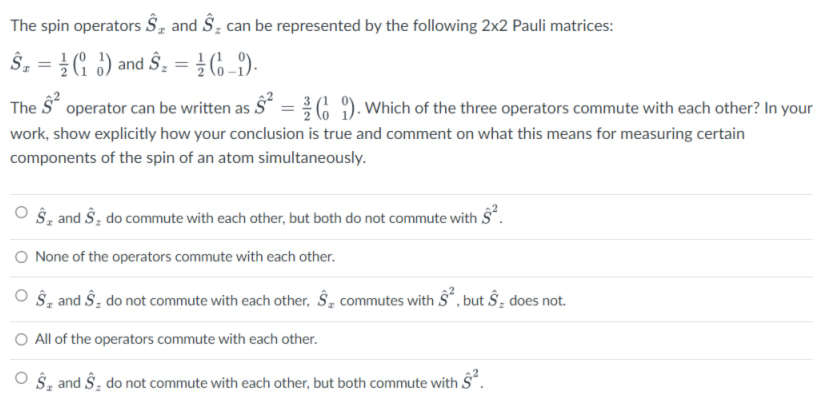The spin operators Ŝ, and Ŝ, can be represented by the following 2x2 Pauli matrices: Ŝ. = } C ¿) and Ŝ; = }6-)- The S operator can be written as S" =C ). Which of the three operators commute with each other? In your work, show explicitly how your conclusion is true and comment on what this means for measuring certain components of the spin of an atom simultaneously. O §, and Ŝ, do commute with each other, but both do not commute with S". O None of the operators commute with each other. Ŝa and Ŝ; do not commute with each other, Ŝ̟ commutes with S", but Ŝ; does not. O All of the operators commute with each other. O §, and Ŝ, do not commute with each other, but both commute with S.
The spin operators Ŝ, and Ŝ, can be represented by the following 2x2 Pauli matrices: Ŝ. = } C ¿) and Ŝ; = }6-)- The S operator can be written as S" =C ). Which of the three operators commute with each other? In your work, show explicitly how your conclusion is true and comment on what this means for measuring certain components of the spin of an atom simultaneously. O §, and Ŝ, do commute with each other, but both do not commute with S". O None of the operators commute with each other. Ŝa and Ŝ; do not commute with each other, Ŝ̟ commutes with S", but Ŝ; does not. O All of the operators commute with each other. O §, and Ŝ, do not commute with each other, but both commute with S.
Related questions
Question

Transcribed Image Text:The spin operators Ŝ, and S; can be represented by the following 2x2 Pauli matrices:
Ŝ, = } C ) and Ŝ,
(6–)-
The
operator can be written as S" = 6 D). Which of the three operators commute with each other? In your
work, show explicitly how your conclusion is true and comment on what this means for measuring certain
components of the spin of an atom simultaneously.
O Ŝ, and Ŝ, do commute with each other, but both do not commute with S".
O None of the operators commute with each other.
O §, and Ŝ, do not commute with each other, Ŝ, commutes with S“ , but Ŝ, does not.
O All of the operators commute with each other.
O §, and S, do not commute with each other, but both commute with S.
Expert Solution
Step 1
Consider the given data as below.
The spin operator,
The spin operator,
The spin operator,
Trending now
This is a popular solution!
Step by step
Solved in 4 steps
